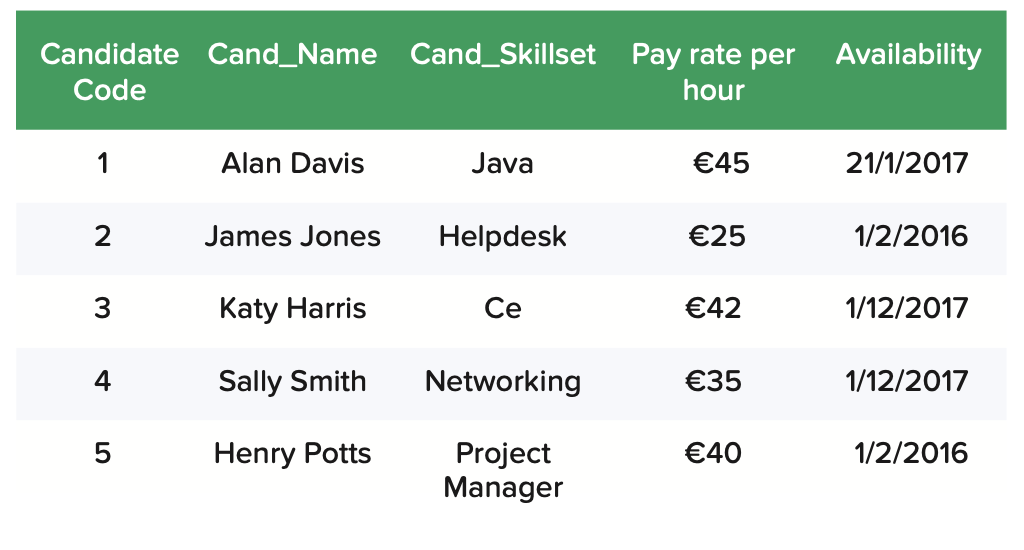We create an estimated 2.5 quintillion bytes of data every day, and this number is only accelerating. To cope with this growing demand, jobs under the umbrella of database specialists are also increasing in number. For recruiters however, learning the ropes of this industry can be intimidating. Endless reams of terminology and jargon can cause even the most seasoned hiring professionals to quiver.
This guide will dispel the myth that you need to be a tech expert to hire in the database recruitment field, with definitions and descriptions that surround it so you can confidently approach the task.

What is a database?
Before diving into database recruiting, let’s start with the basics:
A database is a shared collection of related data that is stored electronically in a computer system.
Databases vary greatly depending on the nature of the organization’s business. For example, AT&T, the USA’s oldest telecommunications company has a database containing call records, to include data such as call time, duration, phone numbers dialled and so on. Amazon holds onto records of their customers, like names and email addresses, wish lists, items purchased and receipts.
In a database’s most common form, data is organized in rows, columns and tables. It can be accessed, managed, modified and analyzed depending on need. RDBMS (Relational Database Management System) is the software used to help us make sense of and optimize the way we use data. It acts as an interface between a database and its end users. Oracle and MySQL are examples of relational database management software.
When all of this data is collected, stored and made accessible through RDBMSs, there needs to be a way that people can interpret the relationship between different data sets. This method is actually driven by a language known as SQL.
Structured Query Language allows communication with databases in order to manage all the data they contain. SQL was first developed in early 1970 at IBM. And it’s still is use today. So, because of its universal applicability, it is an essential tool to have in your belt when working in this field.
Tables
Tables are at the heart of RDBMS function. A database table is a structure that organizes data into rows and columns thus forming a grid. Modern relational database systems rely on a collection of tables. They are each related to each other by sharing common entity characteristics. Both the rows and columns essentially give the table its substance and personality.

So when it comes to creating tables you need to decide which elements of data will be crucial to your business. You then build these tables based on these entities. It is the common characteristics encoded into the tables that allow for relationships to occur.
The different database forms
A database can exist in a variety of forms. Let’s take a closer look at some of the most popular:
- Stand-alone software – A personal use database e.g. Microsoft Access.
- Client-server databases – These databases sit on a mainframe or service system e.g. CRM (customer relationship management) or ATS (applicant tracking system)
- Distributed database – Large database that is split into smaller entities that work together in a unified system.
- Off-site database – A database that doesn’t reside in-house. Other terms include: off-shore, outsourced and visualized.
- Data warehouse – An off-shoot of databases but still related; a data warehouse is a central repository of data from disparate sources. They hold current and historical data in a single place.
Database job roles
Database recruiting can vary depending on the particular project. Most roles will fall under these three categories:
Database developer
Also referred to as database programmers, their primary role is to create the structure of the database. They determine the best system for an organization’s needs, gather data, build, work on functionality and provide technical support and training. Developers will have a keen understanding of technical design skills and understand the appropriate programming languages and codes.
Database testers
If a database project is particularly large-scale, testers will be employed. Their mission is to make sure the system is running smoothly. By creating test scripts, which are small, reusable programmes, they put the database through its paces. A database tester looks for all kinks and glitches that can arise. They are a vital component of a successful database rollout.
Database administrators
More generally referred to as DBAs, their primary role is to ensure the security and health of the database is constantly maintained. They look after data recovery in the case of attacks or glitches, optimizing storage and capacity planning so a database can cope with ever-increasing demands.
Conclusion
The first step in recruiting for database roles is understanding databases. An ability to have a meaningful conversation about this industry with potential employees and hiring managers alike is imperative for success. And while database recruiting can all seem rather overwhelming from the sidelines, with some key knowledge at your disposal, you’re sure to make great hires.
Want to learn more about hiring in the tech sector? SocialTalent has an extensive library of expert content dedicated to just this! Contact us today. And don’t forget to subscribe to our newsletter and follow us on LinkedIn.
The post The beginners guide to: Recruiting for database roles appeared first on SocialTalent.